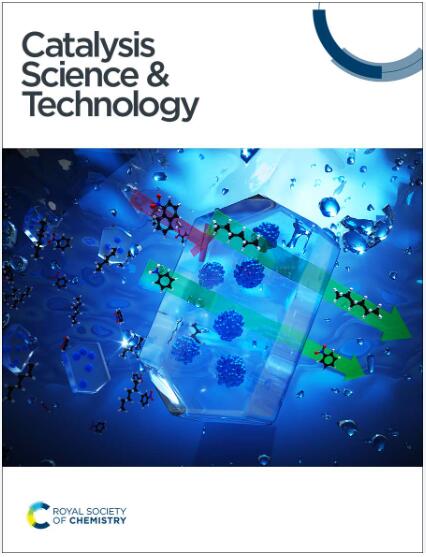The effect of separation distance on hydrogen spillover in Os promoted Co@HCS catalysts†
IF 4.4
3区 化学
Q2 CHEMISTRY, PHYSICAL
引用次数: 0
Abstract
Spillover effects from an easily reduced metal (Os) to a less easily reduced metal (Co) were investigated by use of hollow carbon spheres (HCSs) of different shell thicknesses, x, (x = 16 nm, 28 nm and 51 nm). The Co (10%) was loaded inside the HCS and the Os (1%) outside three HCS supports (Os/Co@HCSx). Temperature programmed reduction, together with BET and XRD studies, were used to monitor the effects of the Os on the Co as a function of HCS shell thickness. When no Os was present on the outside of the HCSs, the effect of H2 diffusion on the two Co reduction peaks was determined. Comparison with the Os containing Co@HCSs catalysts indicated that the two Co reduction peaks were influenced differently by the HCS shell thickness. Spillover of hydrogen could be observed at distances of ca. >100 nm, as shown by the shift of the first Co reduction peak (Co3O4 to CoO) while that of the second reduction peak (CoO to Co) was only observed at distances up to ca. 50 nm. The disordered carbon material is proposed to be responsible for the H transfer reaction between Os and Co. The Os/(Co@HCSx) catalysts were tested for Fischer–Tropsch (FT) activity and the data indicated a drop in the FT activity with shell thickness. This suggests that HCSs require an optimum thickness (to provide stability, good porosity and auto-reduction behaviour) to generate high FT activity/selectivity, with spillover effects aiding the reaction.

分离距离对Os催化Co@HCS催化剂中氢气溢出的影响
利用不同壳厚x、(x = 16 nm、28 nm和51 nm)的空心碳球(hcs)研究了易还原金属(Os)对不易还原金属(Co)的溢出效应。Co(10%)加载在HCS内部,o(1%)加载在三个HCS支架外(o /Co@HCSx)。采用程序升温还原法,结合BET和XRD研究,监测了Os对Co的影响随HCS壳厚的变化。当hcs外部不存在Os时,确定H2扩散对两个Co还原峰的影响。与含Os Co@HCSs催化剂的对比表明,HCS壳厚对两个Co还原峰的影响不同。氢的溢出可以在大约100 nm的距离上观察到,从第一个Co还原峰(Co3O4到CoO)的位移可以看出,而第二个Co还原峰(CoO到Co)只在大约50 nm的距离上观察到。无序碳材料被认为是导致Os和Co之间H转移反应的原因。对Os/(Co@HCSx)催化剂进行了FT活性测试,结果表明FT活性随壳厚的增加而下降。这表明hcs需要一个最佳厚度(以提供稳定性、良好的孔隙度和自动还原行为)来产生高FT活性/选择性,并具有溢出效应,有助于反应。
本文章由计算机程序翻译,如有差异,请以英文原文为准。
求助全文
约1分钟内获得全文
求助全文
来源期刊

Catalysis Science & Technology
CHEMISTRY, PHYSICAL-
CiteScore
8.70
自引率
6.00%
发文量
587
审稿时长
1.5 months
期刊介绍:
A multidisciplinary journal focusing on cutting edge research across all fundamental science and technological aspects of catalysis.
Editor-in-chief: Bert Weckhuysen
Impact factor: 5.0
Time to first decision (peer reviewed only): 31 days
 求助内容:
求助内容: 应助结果提醒方式:
应助结果提醒方式:


